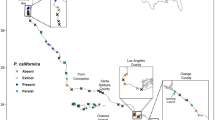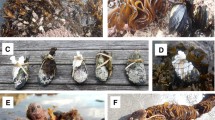Synopsis
A study of recolonisation of rockpools by intertidal fishes on the Wellington south coast, New Zealand, found the assemblage to be resilient and seasonally stable. A total of 26 species from nine families were recorded, dominated by the Tripterygiidae (triplefins) and Gobiesocidae (clingfishes). A pattern of alternating species dominance occurred, with the triplefinsBellapiscis medius andForsterygion lapillum being numerically dominant in summer, but becoming less common in winter and replaced as dominants by the clingfishesTrachelochismus pinnulatus andGastroscyphus hectoris. Juvenile recruits of eleven species occurred in the samples from spring to early summer, however only the aforementioned four species recruit to the intertidal zone in large numbers. The speed of rockpool recolonisation by fishes after extractive sampling is seasonally dependent, being quicker in the summer than winter. In general, recolonisation takes at least one month, but probably fewer than three. While stochastic factors influence assemblage composition in the short term, overall regulation of the fish assemblage of rockpools appears to be primarily deterministic, resulting in an essentially predictable taxonomic structure.
Similar content being viewed by others
References cited
Adams, N.M. 1994. Seaweeds of New Zealand. Canterbury University Press, Christchurch. 360 pp.
Beckley, L.E. 1985a. Tide-pool fishes: recolonisation after experimental elimination. J. Exp. Mar. Biol. Ecol. 85: 287–295.
Beckley, L.E. 1985b. The fish community of East Cape tidal pools and an assessment of the nursery function of this habitat. S. Aft. J. Zool. 20: 21–27.
Bennett, B.A. 1987. The rock-pool fish community of Koppie AIleen and an assessment of the importance of Cape rock-pools as nurseries for juvenile fish. S. Afr. J. Zool. 22: 25–32.
Bennett, B.A. & C.L. Griffiths. 1984. Factors affecting the distribution, abundance and diversity of rock-pool fishes on the Cape Peninsula, South Africa. S. Aft. J. Zool. 19: 97–104.
Berger, A. & M. Mayr. 1992. Ecological studies on two intertidal New Zealand fishes,Acanthoclinus fuscus andForsterygion nigripenne robustum. N.Z.J. Mar. Freshwat. Res. 26: 359–370.
Christensen, M.S. & R. Winterbottom. 1981. A correction for, and its application to, visual censuses of littoral fish. S. Aft. J. Zool. 16: 73–79.
Clarke, K.R. 1993. Non-parametric multivariate analyses of change in community structure. Aust. J. Ecol. 18: 117–143.
Collette, B.B. 1986. Resilience of the fish assemblage in New England tidepools. U.S. Fish. Bull. 84: 200–204.
Connell, S.D. & G.P. Jones. 1991. The influence of habitat complexity on postrecruitment processes in a temperate reef fish population. J. Exp. Mar. Biol. Ecol. 151: 271–294.
Connell, J.H. & W.P. Sousa. 1983. On the evidence needed to judge ecological stability or persistence. Amer. Nat. 121: 789–824.
Darby, M.M.S. 1966. The ecology of fishes in tidal rockpools, with a revision of the common littoral speciesTripterygion nigripenne Cuv. & Val., 1836 (Tripterygiidae: Blennioidei: Teleostei). M.Sc. Thesis, University of Canterbury, Christchurch. 245 pp.
Doherty, P.J. 1991. Settlement versus recruitment in coral reef fishes: effects of post-settlement mortality. pp. 40–45. In: D.A. Hancock (ed.) Recruitment Processes, Bureau of Rural Resources Proceedings No. 16, Canberra.
Duffy, C. 1988. The fish fauna of subtidally fringing macroalgae sampled at Wairepo Flats, Kaikoura. M.Sc Thesis, University of Canterbury, Christchurch. 136 pp.
Fricke, R. & C.D. Roberts. 1993.Grahamina, a new genus for robust-bodied triplefins (Teleostei: Tripterygiidae) from New Zealand and Australia, with description of a new species. Stuttgarter Beitr. Naturk. Set. A 504: 1–21.
Gibson, R.N. 1967. Studies on the movements of littoral fish. J. Anim. Ecol. 36: 215–234.
Gibson, R.N. 1982. Recent studies on the biology of intertidal fishes. Oceanogr. Mar. Biol. Ann. Rev. 20: 363–414.
Grossman, G.D. 1982. Dynamics and organisation of a rocky intertidal fish assemblage: the persistence and resilience of taxocene structure. Amer. Nat. 119: 611–637.
Grossman, G.D., P.B. Moyle & J.O. Whitaker. 1982. Stochasticity in structural and functional characteristics of an Indiana stream fish assemblage: a test of community theory. Amer. Nat. 120: 423–454.
Handford, C. 1979. The habitat, population dynamics and social organisation of two tipterygiid fishes. M.Sc. Thesis, University of Auckland, Auckland. 114 pp.
Holbrook, S.J., M.J. Kingsford, R.J. Schmitt & J.S. Stephens, Jr. 1994. Spatial and temporal patterns in assemblages of temperate reef fish. Amer. Zool. 34: 463–475.
Jillett, J.B. 1968a. The biology ofAcanthoclinus quadridactylus (Bloch and Schneider) (Teleostei-Blennioidea). I. Age, growth and food. Aust. J. Mar. Freshwater Res. 19: 1–8.
Jillett, J.B. 1968b. The biology ofAcanthoclinus quadridactylus (Bloch and Schneider) (Teleostei-Blennioidea). II. Breeding and development. Aust. J. Mar. Freshwater Res. 19: 9–18.
Jones, G.P. 1984. The influence of habitat and behavioural interactions on the local distribution of the wrassePseudolabrus celidotus. Env. Biol. Fish. 10: 43–58.
Jones, G.P. 1987. Competitive interactions among adults and juveniles in a coral reef fish. Ecology 68: 1534–1547.
Lardner, R., W. Ivantsoff & L.E.L.M. Crowley. 1993. Recolonisation by fishes of a rocky intertidal pool following repeated defaunation. Aust. Zool. 29: 85–92.
Mahon, R. & S.D. Mahon. 1994. Structure and resilience of a tidepool fish assemblage at Barbados. Env. Biol. Fish. 41: 171–190.
Mapstone, B.D. & A.J. Fowler. 1988. Recruitment and the structure of assemblages of fish on coral reefs. Trends Ecol. Evol. 3: 72–77.
Mayr, M. & A. Berger. 1992. Territoriality and microhabitat selection in two intertidal New Zealand fish. J. Fish Biol. 40: 243–256.
Meffe, G.K. & T.M. Berra. 1988. Temporal characteristics of fish assemblage structure in an Ohio stream. Copeia 1988: 684–690.
Menge, B.A. 1991. Relative importance of recruitment and other causes of variation on rocky intertidal community structure. J. Exp. Mar. Biol. Ecol. 146: 69–100.
Morton, J.E. & M.C. Miller. 1968. The New Zealand sea shore. William Collins Sons and Co., Glasgow. 653 pp.
Paulin, C.D. & C.D. Roberts. 1992. Te ika aaria o Aotearoa (The rockpool fishes of New Zealand). Museum of New Zealand, Wellington. 177 pp.
Paulin, C.D. & C.D. Roberts. 1993. Biogeography of New Zealand rockpool fishes. pp. 191–199. In: C.N. Battershill, D.R. Schiel, G.P. Jones, R.G. Creese & A.B. MacDiarmid (ed.) Proceedings of the Second International Temperate Reef Symposium, 7–10 January 1992, Auckland. NIWA Marine, Wellington.
Pielou, E.C. 1977. Mathematical ecology. John Wiley & Sons, New York. 286 pp.
Prochazka, K. & C.L. Griffiths. 1992. The intertidal fish fauna of the west coast of South Africa — species, community and biogeographic patterns. S. Afr. J. Zool. 27: 115–120.
Ross, S.T. & T.A. Doherty. 1994. Short-term persistence and stability of barrier island fish assemblages. Est. Coast. Shelf Sci. 38: 49–67.
Ruck, J.G. 1976. Studies on the development and osteology of some New Zealand inshore fishes. Ph.D. Thesis, Victoria University of Wellington, Wellington. 339 pp.
Ruck, J.G. 1980. Early development ofForsterygion varium, Gilloblennius decemdigitatus andG. tripennis (Pisces: Tripterygiidae). N.Z. J. Mar. Freshwat. Res. 14: 313–326.
Sale, P.F. 1978. Coexistence of coral reef fishes — a lottery for living space. Env. Biol. Fish. 3: 85–102.
Sale, P.F. 1991. Reef fish communities: open nonequilibrial systems. pp. 564–598. In: P.F. Sale (ed.) The Ecology of Fishes on Coral Reefs, Academic Press, San Diego.
Sale, P.F., J.A. Guy & W.A. Steel. 1994. Ecological structure of assemblages of coral reef fishes on isolated patch reefs. Oecologia 98: 83–99.
Smale, M.J. & C.D. Buxton. 1989. The subtidal gully fish community of the eastern Cape and the role of this habitat as a nursery area. S. Air. J. Zool. 24: 58–67.
Smith, C.L. 1973. Small rotenone stations: a tool for studying coral reef fish communities. Amer. Mus. Novit. 2512: 1–21.
Syms, C. 1992. Spatial scale and the structure and dynamics of a blennioid fish guild. M.Sc. Thesis, University of Auckland, Auckland. 56 pp.
Thompson, S.M. & G.P. Jones. 1983. Interspecific territoriality and competition for food between the reef fishesForsterygion varium andPseudolabrus celidotus. Mar. Biol. 76: 95–104.
Thomson, D.A. & C.E. Lehner. 1976. Resilience of a rocky intertidal fish community in a physically unstable environment. J. Exp. Mar. Biol. Ecol. 22: 1–29.
Wilkinson, L. 1990. SYSTAT: The system for statistics. SYSTAT, Inc., Evaston. 677pp.
Zar, J.H. 1984. Biostatistical analysis. Prentice-Hall, Englewood Cliffs. 718pp.
Author information
Authors and Affiliations
Rights and permissions
About this article
Cite this article
Willis, T.J., Roberts, C.D. Recolonisation and recruitment of fishes to intertidal rockpools at Wellington, New Zealand. Environ Biol Fish 47, 329–343 (1996). https://doi.org/10.1007/BF00005047
Received:
Accepted:
Issue Date:
DOI: https://doi.org/10.1007/BF00005047




